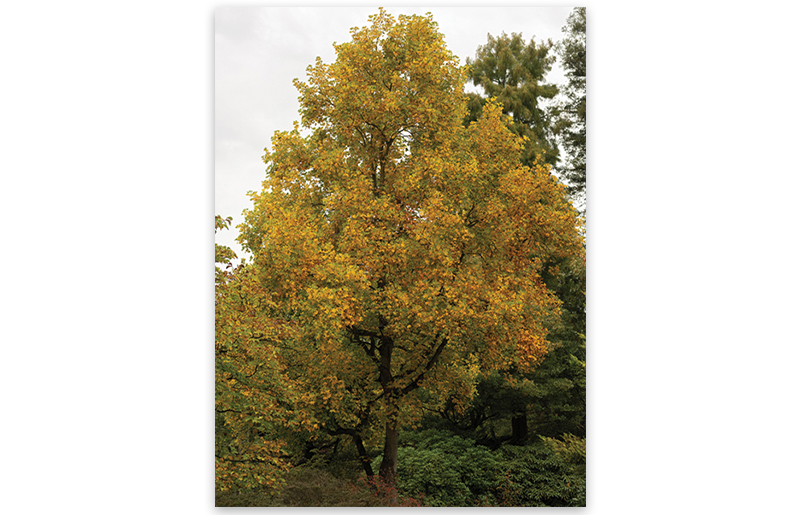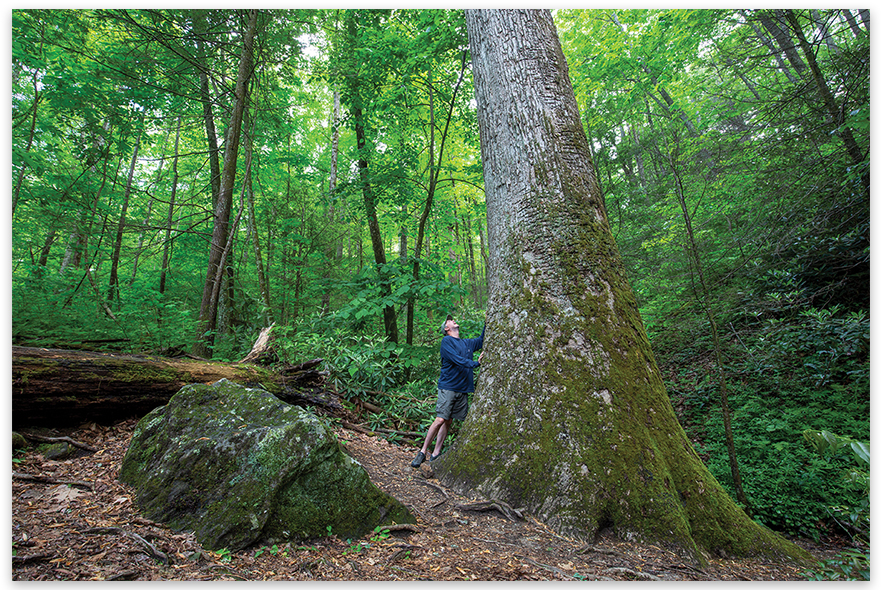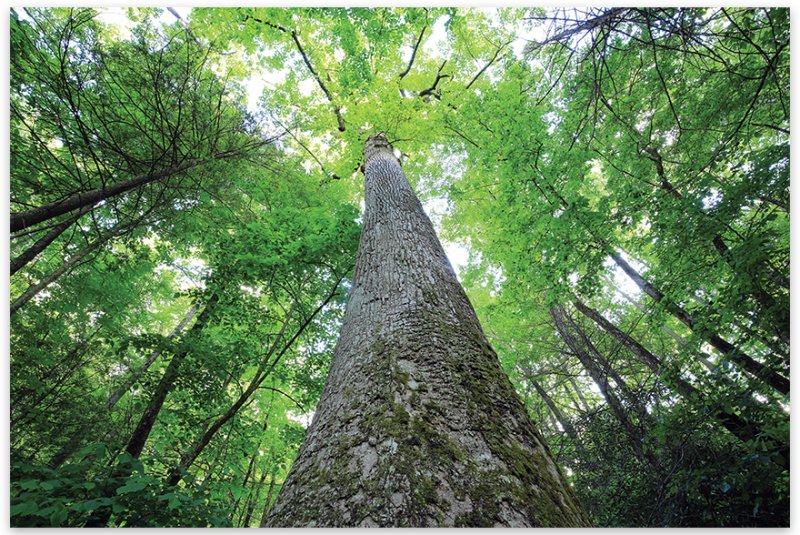The Magnificent Mountain Poplar
The Magnificent Mountain Poplar: An abundant resource, poplar wood has a staggering mountain history
Ask anyone to name the signature hardwoods of Western North Carolina’s mountains. They’ll talk of chestnut, oaks, maple, walnut, and maybe hickory. Missing from most everyone’s list will be the most heavily harvested hardwood—the one widely used by everyone from ancestors of the Cherokee people to makers of today’s most modern furniture—the tulip tree, aka yellow poplar, or just plain poplar.
But wait a minute—the ever-popular poplar Liriodendron tulipifera is not a poplar at all. Instead, the tallest and strongest of Southern Appalachian hardwoods is a member of the genus Magnolia not Polulus, the genus including black poplars, gray poplars, and the hybrid known as Carolina poplar.
Magnolias, a tree forever associated with the South, have showy white flowers. Those of tulip poplars are equally as dramatic. Petals range from light yellowish-green to almost-but-not-quite white. The bases of tulip tree flowers look like they’ve been dipped in flaming orange paint. Magnolias are pollinated by beetles; lirodendrons, by bees. Birds spread the seeds of magnolias while those of liriodendrons are dispersed by wind.
One writer described the tulip poplar blossoms as colorful teacups prodigious with nectar. A bee can fill up with nectar with a visit to just one blossom rather than traveling to dozens of flowers before returning to its hive. Pure poplar honey, available from Asheville Bee Charmer (ashevillebeecharmer.com), is dark and richly flavorful, tasting faintly like fig jam.
Liriodendron tulipifera is an ancient species dating back 70 million years to the Cretaceous age when warm shallow seas spread across the piedmont. During the ice ages, fifteen species of Liriodendron disappeared, leaving only one, which found refuge in the deep South. As the climate warmed, it spread northward, repopulating terrain as far north as southern New York.
Call it what you may, Liriodendron tulipifera is a signature tree of the Southern Appalachians.
Tulip poplars may live for more than 200 years, and some make it past 400. Poplar can reach more than 200 feet in height with diameters up to ten to twelve feet. Trees topping 150 feet are not rare. More common are trees of eighty to 120-feet high. Relatively fast growing in moist soils, particularly in sheltered coves, trunks of mature poplars may reach twenty to thirty feet before sprouting branches.
Indigenous Use
Long runs of knot-free wood made poplar ideal for construction lumber. In addition, poplar is known for its strength and resistance to warping, shrinking, and rot. Dried wood varies in color from creamy white to almost-yellow and can be faintly streaked. Poplar is the most buoyant of mountain hardwoods. Long before the arrival of Europeans, Cherokee and other Native Americans prized poplar logs for their dugout canoes.
Native Americans felled poplars with stone axes. Because of their long straight grain, poplars were fairly easily split in half. While still green, the ends of each half were tapered, creating what would become the canoe’s bow and stern. The halves must have been left to dry for a year or two. Then fires were built on the flat top of the log and, using stone adzes, charred wood was hogged out of the center until the vessel was deep enough to carry passengers and cargo.
Just imagine the labor involved in shaping a canoe, chop by chop with stone axes and adzes not nearly as sharp as a garden hoe. Sixty-four year-old Daniel Boone had it much easier when iron tools were used to hollow out a sixty-foot poplar log to create the pirogue (dugout canoe) which carried some of his kin down the Ohio River when the family moved from Kentucky in 1799 to what would eventually become Missouri.
Easily shaped by stone, antler, and bone tools, poplar was no doubt a wood put to a number of household uses by Cherokee and their ancestors. They fashioned bowls and dippers. From its bark, they made baskets and pouches. Dried bark was easily worked into a web of fine filaments, readily ignited by rapidly spinning a bone-dry stick in the notch of another stuffed with a wad of poplar tinder. Filaments could also be twisted together to make twine.
A Versatile Choice
Colonial settlers favored the wood for building their cabins and, later, for framing houses. Its strength and straightness made it ideal for sills, the heavy logs on which early cabins and later houses were built. Adzes of iron, and later, steel, hewed poplar into beams that supported lofts and even upper stories as buildings improved. Logs of poplar were halved, their split-side smoothed with adzes, then laid as puncheon floors. Heaving their saw up and down and up and down, two men working in pits—one standing atop a frame holding a log and the other beneath—ripped flat planks from butt logs of big poplar. Only the finest mountain homes boasted wood plank floors. Technological innovation led to waterwheel-powered sawmills, and as a result poplar boards became more common in colonial construction.
According to Margo Reynolds, writing in Arnoldia, the quarterly magazine of Harvard University’s Arnold Arboretum, “Pine, oak, walnut, butternut, and chestnut were among the preferred woods for colonial furniture making and sundry other purposes, but another wood (poplar), less well known, served the colonists reliably and well….”
As had Cherokees, colonists found poplar an easy wood from which to fashion household utensils in addition to bowls and dippers because, unlike oak and other woods, poplar is virtually odor free. It was the wood of choice for churns and containers for butter, cheese, and lard. Other containers ranged from tiny pill boxes to berry baskets to blanket chests to hogsheads for tobacco. Among today’s valuable antiques are Bible boxes carved from poplar.
Newly-invented machines that milled wood into trays arrived in the 1850s. By the end of the century, sets of wooden bowls that nested could be found in many kitchens. Woodwork in fine Southern homes was occasionally carved from poplar, which or mahogany. Poplar was also easy to paint, and paint resists peeling on poplar. Farm tables and chairs of poplar were common and remained so into the 1930s and 40s.
I never gave poplar much thought as a furniture wood until I bought an 1840s vintage house in the northern Virginia area of Upperville. I needed a table and chairs for the kitchen. Friends of mine, dealers in American primitive antiques, found them for me and apologized that they weren’t walnut or maple.
The table is topped with three poplar planks polished as smooth and brown as tanned leather. The three spindle-back chairs are not so finely finished but have served well. For most of a quarter of a century, I’ve eaten most of my meals at that table and never failed to admire the wood and its gentle grain. The planks, I suspect, came from the Blue Ridge, the northern end of the Southern Appalachians. Ditto with those of the blanket chest in the bedroom.
And who would have thought that this, the most common and least expensive of hardwoods, is highly favored for pipe organs. Because poplar is dimensionally stable, easily precisely carved, and accepts a fine finish that lasts, poplar is highly desirable for valves opening and closing pipes. And in a similar cultural vein, Edgar Allen Poe’s eerie 1843 detective fiction The Gold-Bug, set in Sullivan’s Island, S.C., uses the seventh limb of a Liriodendron tulipferum to house a lodged skull hiding buried treasure.
Building America
In the decades following the Civil War, American industry began to boom. Steam power replaced waterwheels. Railroads replaced canals and turnpikes. Manufacturing blossomed and was consolidated in large factories close to sources of coal, raw materials, and rail. Villages where railroads crossed rivers grew into small cities as manufacturing plants developed nearby. Coastal cities exploded into large urban centers. Immigrants poured into the country, many taking factory jobs which drew millions from farms as well.
Demand for wood for furniture and building lumber increased exponentially. But forests in the Northeast and upper Midwest had already been pretty much stripped of marketable timber. East of the Mississippi River, only one forest reserve remained: the Southern Appalachians between western North Carolina and East Tennessee. Even as early as the 1860s, North Carolina mountain forests had been identified as “truly magnificent, especially near the foot of the hills….”
Until railroads reached Asheville, Waynesville, and Canton in the 1880s, logging was mostly restricted to farmers cutting timber for either building or firewood. Yet timber cruisers were already prowling mountains searching for stands of commercially-marketable hard and soft woods.
Loggers first targeted stands of black walnut, cherry, and ash for furniture. Near Waynesville in the mid-1880s, the G. V. Litchfield Co. built a sawmill and contracted for four million board feet of walnut, and later, massive amounts of cherry and oak. Soon poplar was added to the mix. Across the Great Smokies in Tennessee’s Little River drainage, stands of poplar along lower reaches of tributaries were logged first before moving upstream to less accessible stands of furniture wood.
Logging was incredibly arduous and dangerous. Two sawyers pushing and pulling cross-cut saw could probably fell a tree in less than an hour. With smaller saws and axes, they sheared limbs from its trunk which was then cut into lengths to be “skidded,” hooked by chain to horses, to the edge of a stream impounded by a log and rock splash dam.
Once logs were floating, the dam would be opened, sometimes by dynamiting, and the logs would ride the crest of the flood down to a river like the French Broad or the Pigeon. Aside from its properties for construction, poplar was favored for splash dam logging because it was so much more buoyant than other hardwoods.
Working for George Vanderbilt III, forester Gifford Pinchot planned splash dams on Mills River. His assistant Carl Schenk, newly arrived from Germany, doubted the wisdom of releasing an uncontrollable flood of timber down a steep creek. Pinchot refused Schenk’s advice, opened the dam, and the resulting torrent of logs washed out bridges and scattered jumbles of timber in farmers’ fields. Many of the logs were, no doubt, poplar.
Poplar does well on lands that have been previously logged. Maturing rapidly, its high crown and large leaves shade slower growing maples and oaks. As of 2002, poplar was the most abundant tree growing on North Carolina’s timberlands. Soft maple was a fairly close second. And when it came to diameter, poplar was by far the largest.
Poplar is prolific. Growing rapidly, poplars can produce marketable timber in twenty to thirty years, an ideal species for second-, third-, or even fourth-growth forest. Loggers in Western North Carolina sell poplar to a number of sawmills in Haywood County just across Cataloochee Cove from Big Creek, home of the logging town of Crestmont that thrived a century ago until all the timber was cut, the mill shut down, the railroad pulled up, and remaining townspeople moved out as Great Smoky Mountain National Park took over. Most poplar logged today gets chipped for use as particle board or paper-making pulp or peeled as fine-grained veneer for plywood for cabinets that will be stained or painted.
A few master craftsmen like Brian Boggs of Brian Boggs Chairmakers here in Asheville favor it for its inner strength and ease of workmanship. “Poplar is the backbone of many of our designs,” he says. His chairs, tables, and cabinets are finely finished with native walnut, curly maple, and cherry, “the woods," he says, “people today want to see.”
Handmade by Boggs, his furniture can be found scattered across the region, where it adds a touch of natural history into both commercial and residential modern spaces. Visit 5 Walnut Wine Bar and the Smoky Park Supper Club for a glimpse. Made to order, Boggs is able to incorporate poplar's legacy, durability, and functionality into his pieces. Although poplar isn't always a favored choice today, its impact is lasting.
This spring, walk any of the trails in Pisgah and Nantahala National Forests or the Great Smokies and you’ll see for yourself hundreds of these, the most magnificent mountain hardwoods, in full bloom.

An Herbal Hardwood
Restorative benefits of tulip poplar bark and leaves have long been known to Cherokees and their ancestors, to colonial settlers, and to today’s advocates of natural cures. Inner bark of the tree’s root is a strong stimulant and natural source of salicylates, a principal component of aspirin (acetylsalicylic acid). According to King’s American Dispensatory, a highly respected, exhaustive two-volume guide to pharmaceuticals published in 1905, strong tonic from tulip poplar root bark has palliative effect on chronic rheumatism, mild cardiac conditions, and gastric/intestinal diseases. It was also said to be good for deworming humans and horses.
During the Civil War, the bark substituted for unavailable quinine as a cure for malaria. Tea made from the bark was used to clean wounds. A saturated poultice promoted healing of sores and scrapes. Pressing a salad of chopped leaves against one’s forehead relieves headaches, and chewing raw root bark purportedly serves as an aphrodisiac. Such claims, like history, were apparently written by survivors.

The Bob Padgett Tulip Poplar.
Popular Poplar Walks
Walk virtually any trail near the Cradle of Forestry in Pisgah National Forest in April or May and you’ll find poplar in bloom. Your route will be fringed with trillium, trout lily, bluebells, bluets, and scores of flowering other native wildflowers.
A little further afield near Highlands is the huge Bob Padgett Tulip Poplar, named for the ranger who kept this 400-year-old, then-127-foot tall, twenty-foot circumference Liriodendron tulipifera specimen from being cut down in 1966. Coming from Cashiers, turn left on Main Street. It becomes Horse Cove Road (SR 1063). After a two-mile winding ride over the ridge, Rich Gap Road comes in from the right. Park at the Forest Service kiosk, climb the steps across the road, and follow the path through a grove of poplar to the huge tree.
Across the mountains off US 321 just south of Cosby, T.N., the Maddron Bald Trail leads to Albright Grove, one of the last stands of big old-growth popular in the Great Smokies. The moderate 6.7-mile round-trip hike is well worth it. On the way you’ll pass Baxter Cabin, built by Willis Baxter in 1889 from a single huge chestnut tree as a wedding present for his son.
